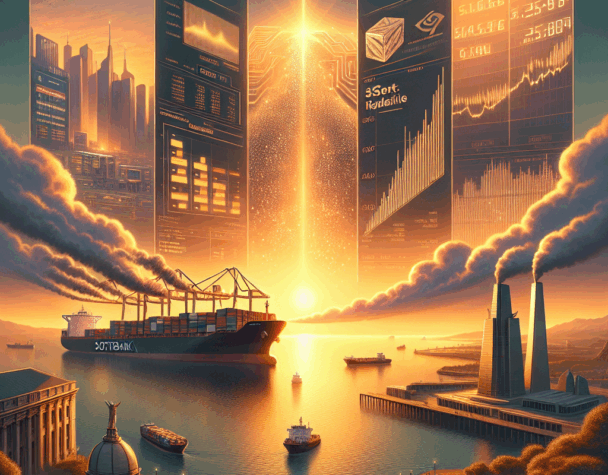
Morebaya Port Launches; SoftBank Sells NVDA
Wed, November 12, 2025Introduction
Two discrete but consequential events surfaced in the past 24 hours that investors should not ignore: Guinea’s long-awaited Morebaya port has begun operations, opening logistical access to the immense Simandou iron‑ore deposits, and SoftBank disclosed the sale of its entire stake in Nvidia while CoreWeave issued a downward revision to revenue guidance. One development has immediate implications for raw‑materials flows and industrial pricing; the other rearranges capital and demand signals within the AI‑hardware ecosystem. Below, I unpack what happened, why it matters, and actionable takeaways for different investor profiles.
Major Development: Morebaya Port Unlocks Simandou Iron‑Ore
After years of planning and investment, the renovated Morebaya port in Guinea is now operational, allowing shipments from the Simandou iron‑ore deposit—one of the world’s largest untapped sources. The infrastructure package backing Simandou has been described in reports as a roughly $23 billion project capable of handling up to about 120 million tonnes of iron ore annually.
Why this port matters beyond Guinea
Simandou’s scale is such that bringing its production online can materially alter the supply picture for iron ore used in steelmaking. Think of it like turning on a new major faucet in a global water system: even if demand stays steady, the sudden additional supply reduces pressure elsewhere and can depress prices downstream. China‑linked operators and international miners have stakes in the project, so geopolitical alignments and trade flows will be important to monitor.
Investment implications
- Commodities and materials exposure: Increased iron‑ore shipments are likely to weigh on prices for iron and steel inputs over the medium term, affecting margins for miners and steelmakers differently depending on cost positions.
- Industrials and construction: Lower input prices can benefit steel‑using sectors (heavy equipment, construction) but can harm incumbents with higher cost bases.
- Emerging‑market and geopolitical risk: Investors should reassess supply‐chain exposure in West Africa, consider counterparties’ sovereign risk, and track export infrastructure security.
Minor but Significant: SoftBank’s Nvidia Exit and CoreWeave’s Downgrade
In a separate but headline‑grabbing move, SoftBank sold its entire stake in Nvidia—reportedly a position valued at roughly $5.8 billion—redirecting capital toward its own AI ventures. At the same time, CoreWeave, a large cloud provider concentrated on GPU capacity, trimmed full‑year revenue guidance to a $5.05–5.15 billion range from prior guidance of $5.15–5.35 billion and lowered capex expectations.
What this signals about AI hardware demand
SoftBank’s divestment is notable because it represents a reallocation of capital within the AI ecosystem: large investors are taking profits or shifting funds from public chip exposure into private, vertically integrated AI plays. CoreWeave’s guidance cut suggests near‑term demand softness or a recalibration of deployment schedules for GPU capacity among hyperscalers and enterprise customers.
Niche consequences for focused investors
- Chip equities and ETFs: Large, visible trades and guidance revisions increase short‑term volatility. Investors should separate structural secular demand for AI compute from cyclical capex timing.
- Data‑center REITs and GPU cloud providers: Slower capex growth may ease pricing pressure for colocations but could slow revenue expansion for GPU‑focused cloud providers.
- Private vs. public allocation: Watch whether capital continues to flow from public chip equities into private startups and proprietary AI stacks—this can compress listed valuations while inflating private rounds.
Cross‑Cutting Themes and Comparative Impact
Although the Morebaya opening and the SoftBank/CoreWeave news operate in different domains, both reflect how infrastructure—physical or financial—reshapes supply, pricing, and competitive advantage. The Morebaya port is literal logistics infrastructure unlocking raw material flows; SoftBank’s sale and CoreWeave’s update reveal financial and compute infrastructure shifts that affect where AI value accumulates.
Analogy
If you imagine the economy as a city: Morebaya is like building a new shipping terminal that routes bulk goods faster and cheaper, changing which districts produce and consume. The SoftBank/CoreWeave moves are like a major investor selling downtown real estate to build a private campus — funds and demand shift from publicly traded towers into new private facilities.
Practical Steps for Investors
- Reassess exposure to iron‑ore and steel producers: Review cost curves—low‑cost producers fare better if prices decline; high‑cost names may underperform.
- Monitor geopolitical developments in West Africa: Port operations can be affected by infrastructure security, regulatory changes, and export agreements.
- Differentiate AI investment strategies: Separate long‑term secular growth in AI compute from short‑term capex cycles; consider diversified exposure (hardware, software, cloud services).
- Watch earnings and guidance from hyperscalers and GPU providers: These will offer the clearest near‑term signals about demand and utilization.
Conclusion
Yesterday’s Morebaya port opening in Guinea and SoftBank’s sale of its Nvidia stake (paired with CoreWeave’s revenue cut) deliver two distinct shocks: one to commodity supply chains and one to capital flows within the AI infrastructure niche. The Morebaya launch unlocks potentially massive iron‑ore exports from the Simandou region—pressure that could push down steelmaking inputs and reverberate across materials and industrial stocks. Meanwhile, SoftBank’s divestment and CoreWeave’s guidance adjustment signal a rebalancing of investor capital and a potential softening or repricing of near‑term GPU demand. For investors, the immediate task is to map portfolio exposures to these structural moves—adjust commodity and industrial positions based on cost advantage and sovereign risk, and recalibrate AI/hardware allocations with an eye on capex cycles and private‑vs‑public capital shifts. Both stories underscore that infrastructure—physical ports or compute networks—remains central to where value is created and redistributed.
